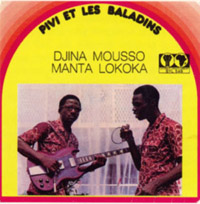
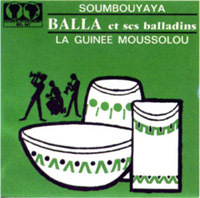
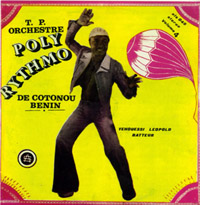
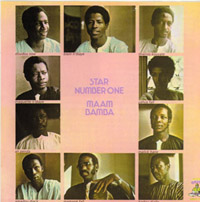
Popular African Music
The Popular African Music label is dear to my heart. You will note four of their titles made my African Top Fifty: Ngoma: Souvenir ya l'Independance, Balla et ses Balladins' Objectif Perfection, Le Super Cayor et son Salsa Mbalax' Sopenté, & Sweet Talks' Hollywood Highlife Party.
Popular African Music has been around for forty years, consequently Günter Gretz' first dozen or so releases came out on vinyl (ah, the good old days): I seem to have mislaid my Etoile de Dakar albums, Absa Gueye, & Xalis which came out in 1980 and showed his initial interest in Senegalese music. I played the side with "Jalo" countless times. And those were the days of detailed sleeve notes so I began my education reading Gretz's (& the other scholars he called on) voluminous liner notes, often with mouth-watering discographies added. With Germanic precision, Gretz announced that he was going to release a classic album in every style of Popular African Music, fulfilling his label's name. From Ghana he released A. B. Crenstil's Moses LP then followed up by collecting it along with Sweet Talks' Hollywood Highlife Party, a truly great party album, for the CD issue. From Guinea he found Sona Diabaté and issued two albums by her: Kankele-Ti and Garé Garé. From Malawi he issued Donald Kachamba's Kwela music on Somanje-manje, and a classic from Tanzania: Mlimani Park's Sungi, which was captured live on their first ever European tour. Just when we were getting used to great things from Günter he started to blow our minds completely.
In 1989 Gretz reached Zaire in his encyclopedic project. What could he possibly come up with? At that point the soukous craze was taking off and I, like a lot of others, was spending all my disposable income on Zairois vinyl. So Günter drops the big one: He unearthed two totally obscure Sam Mangwana albums released in Abidjan in the early 80s, four long tracks, two of them celebrating Mozambiquan independence (Sam is Angolan so his native tongue is Portuguese), and two more that were outtakes (a ridiculous word in this context) from the immortal 1982 OK Jazz session that yielded up "Co-operation." I could not believe my ears: two more brilliant tracks with the same firey energy as "Odongo"! Of course, neither Franco not his french labels thought to collect all these tracks on one LP or CD. The discography of Mangwana, included in the liner notes, became a shopping list and I annotated it as I found tracks on other albums and hunted down the rarer albums. (I found a rare African All-Stars album at Anvers Music in Paris and took it up to the counter but, search as they might, they couldn't find the record that went with the sleeve! I was crestfallen.)
In the 90s Gretz issued three albums by Kante Manfila as a series called Kankan Blues, but then, in 1993, no one was prepared for the totally sublime Balla et ses Balladins. Even those of us who diligently sought out the old 1970s LPs on the Syliphone label from Conakry, were not prepared for Objectif Perfection. Never was an album more aptly named, never was a CD so completely perfect! Even the last cut, "Reminiscin' with Balla and Pivi," which is a 3-minute conversation with the old bandleaders that comes on after a long pause and the sound of an old scratchy album reaching the inner groove and ejecting, is not irritating, as it would be on any other album.
In 1996 Gretz teamed up with the University of Mainz for two releases that showed scholarship and excitement can actually go hand-in-hand. These were the Ngoma label compilations: The roots of Zairois music from 1948 through Independence.
Back to Senegal: In 1999 he issued Orchestre Baobab's Roots and Fruits, a collection culled from their (at that point in time) still-obscure catalogue, before the group reformed and shot to overnight fame. In 2003 he provided the same service for Orchestre Poly-Rythmo de Cotonou, bringing us a first taste of Benin funk. This release so excited Samy Ben Redjeb that he rushed off to Benin to find the band members and assemble as much of their material as possible. As a consequence of the PAM CD we now have the amazing series of juicy reissues on Analog Africa. In a nice collaborative effort, Popular African Music picked up from Dakar Sound, who had issued two CDs by Number 1 de Dakar, and in 2004 Gretz gave us No 3 de No 1. Number One were one of the bands who reinterpreted Cuban rhythms in Senegal in the 1960s, their main vocalist was the great Pape Seck, but they also had Mar Seck and Nicolas Menheim on vocals. Another Gretz discovery was le Super Cayor, more smoking Senegalese music based on salsa but with mbalax starting to creep in. One of Gretz's most amazing achievements was taking a group of Senegalese salseros to Havana in 2001 to record in a truly amazing session.
Long story short: Gretz issued an "out of africa" series and an "african dancefloor classics series," and in my never humble opinion, serious fans of African music need all of these releases. The packages are excellent, with rare photos and legible typography in a distinctive style (lowercase Garamond is his house face). Not only is the music consistently great, each disc has extensive liner-notes and in most cases, the discographies will set you dreaming of rare 45s and unknown cassettes which might turn up some day. If you contact Gretz via his website he says he has copies of some of his earlier albums available but is too lazy to list them, so seek and ye shall find.
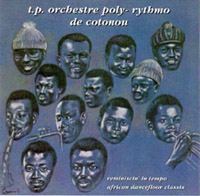
T. P. ORCHESTRE POLY-RYTHMO
REMINISCIN' IN TEMPO (popular african music PAM ADC306)
It strikes me as really odd that people will pay $350 for a scratched LP on EBAY just to boast that they own it. It's not like they have a real connection to it, probably never heard of Benin (which used to be Dahomey), couldn't name the President or tell you the names of any famous Beninois -- even members of this band. So not having $$$ for such frippery I finally found the Popular African Music CD in the REMINISCIN' IN TEMPO series.
This PAM album, which came out in 2003, is the tip of the iceberg. Günter Gretz had found a dozen albums and sampled three of them for this 77-minute extravaganza. The band is still extant and has been working for over 40 years. Being the top band in Cotonou they got to back all the visiting artists: this helped their adaptability to different rhythms & gave them the chops to play a song for ten or fifteen minutes. The speedy guitarist launches into "Wimoweh" during the bridge in "Oh bea"! Local stars such as Angelique Kidjo and Gnonnas Pedro (there's your JEOPARDY answer) also used them in the studio. They toured widely and during a 1980 tour of Angola were issued firearms for protection in case of a very negative reaction from the audience! But in Libya zealous customs agents destroyed their amplifiers looking for hidden contraband. And piracy took its toll on their sales, so their career ground to a halt. Soukous fans will appreciate hearing the early Theo Blaise Kounkou track "Dety motema." He went on to join Sam Mangwana's African All Stars & recorded half a dozen albums in Paris (now out on 3 CDs) that are top-notch.
The secret weapon of the band is Yehoussi Leopold, their churning crankshaft, who is a monster on the drumkit and produces all the polyrhythm you could want. Lead-guitarist Bernard Zoundegnon, a.k.a. Papillon, is the main composer. He likes riffs that sound "flat" to Western ears, reflecting the influence of Oriental Brothers in neighboring Nigeria, though his arpeggiated style is more a reflection of Congo guitar styles. You know they had to be unique for Tidiani Koné, saxophonist and leader of Le Rail Band du Mali, to abandon his successfully stint in Bamako & join the Cotonou team. While Benin is a francophone country, it is sandwiched between those anglophone giants Ghana and Nigeria so it got the best of both worlds, and the band would often go to Lagos to record and use the advanced facilities there to produce 45s. Of course this meant they also got close exposure to the Afro-funk movement sweeping Lagos in the early 1970s. The heart of the PAM compilation is two 17-minute tracks, originally issued as the album "Cheri coco" / "Mille fois merci" (Albarika Stores 038). Ostensibly a ballad, "Cheri coco" hits the ground running and the guitarists blaze off in a blur of dextrous phalanges, while the drummer sends his high hat into a gnat-biting frenzy. It's reminiscent of Theo Blaise's work with Mangwana and suggests another influence on the African All Stars (or vice versa, the track is from 1977, the same time as "Les Champions" and a year before Theo Blaise joined Mangwana's group). There's even a radical tempo change in the middle, like the B side heard upside down. The sound quality drops off for the last two Latin numbers with a jerky Mellotron pretending to play piano montuno. However they are definitely cooking and demonstrate the popularity of Guillermo Portabales in Benin. This could be the greatest unknown band ever.
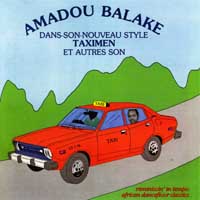
AMADOU BALAKE
TAXIMEN ET AUTRE SONS (Popular African Music African Dancefloor Classics 308)
Amadou Balaké may be new to your ears but he's big in Abidjan. He was born in Ougadougou and gigged with bands in Ghana before leaving his native Burkina Faso for Ivory Coast. He teamed up with Aboudou Lassissi, the super-producer of Abidjan in the late seventies, and followed him to New York for more recordings and then on to Paris where the two lived and worked for a spell. He also sang with Africando on the Martina album. OK, so now you've heard of him. He was included on GOLDEN AFRIQUE vol 1 and here's an hour more of his music, which is a pan-African mix and really enjoyable. At first I was reminded of Gnonnas Pedro who also managed to include Salsa, highlife and Islamic-influenced music into his diverse sets. The title track, "Taximen," tells of unfortunate adventures among the nasty cabbies of Abidjan. We also have highlife numbers and a Malian blues, "Toungaranké," which sounds like Super Biton de Ségou to me. Back to Ghana for "Kikiriki": the album keeps bopping about in a most exhilarating way. The tracks were drawn from two different albums recorded in Nigeria but flow well together. The last three cuts are classic Cuban son, and much longer than the previous tracks. They don't quite fit with the dance concept, but it makes a good contrast to what's gone before. For me it's like a separate (not unwelcome) album.
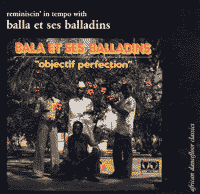
BALLA ET SES BALLADINS
REMINISCIN' IN TEMPO (Popular African Music ADC302)
Guinea is one of the Socialist African countries that fostered state bands and managed to cultivate their musical heritage throughout the early years of independence by actively supporting the best musicians. The Syliphone label of Conakry documented the output of these bands, in singles, compilations and LPs. Now some of the cream is coming out on CD, thanks to the painstaking research of Günter Gretz of the Popular African Music label.
One of the legendary Guinean bands of the 1960s and 70s, Balla and his Balladins were half of the state-funded Syli Orchestre National founded in 1959 that split in two -- the other half becoming Keletigui and his Tambourinis, that featured Keletigui and Momo "Wandel" Soumah on horns. In addition each of the two bands got a singer named Kante Manfila, both grandsons of another musical Kante Manfila and cousins of the more famous singer of that name who started with Les Ambassadeurs.
Balla (on trumpet) and his buddy Pivi (trombone & alto sax) had studied in Dakar and were music teachers when the group was formed. In Guinea they were considered intellectual folklorists for their interest in traditional music. After the group swelled to fifteen members, half of them left with guitarist Sekou Diabaté (Not the Sekou Diabaté aka "Diamond Fingers" of Bembeya Jazz!) to back Miriam Makeba. In recent years, sadly, funding sources have dried up and many of the bands are defunct.
A large ensemble works changes on rumbas, merengues, and other Cuban rhythms by adding the unmistakable passion of Islamic vocalists and African percussion, overlain with an acid-tone electric guitar influenced by Jeff Beck. The tempo slows to a moody, smoky dream for some reverie-inducing sax and guitar interplay.
There are two versions of the song "Sara" on this compilation. "Sara" is a haunting love song about a noble lady from the savannah who underwent torture because she swore love to a poor young peasant. It was written and sung by Kante Manfila and features a kora-like guitar solo by Docteur Diabaté on the version recorded in 1970. It starts slowly like a lot of Guinean songs with the horns and guitar alternately punctuating the melody, a lot of echo on the voice, and the percussion (drums, congas, guiro, shekere) holding back. The bass guitar often plays percussively as well, so it's a rich and rewarding musical trip. Once the main story has been told, the percussion comes to a full boil and the guitar starts to scale the heights of imagination. The horn arrangements, featuring up to three saxes and clarinet, as well as trumpet and trombone, are especially inventive. Guinean pop music as a whole is very complex and interesting (the epics recounting historical tales, as well as modern satire, were a staple of bands like Horoya, Bembeya Jazz, and Super Boiro Band), but the output of the Balladins was magic.
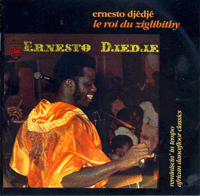
ERNESTO DJÉDJÉ
LE ROI DU ZIGLIBITHY (Popular African Music ADC305)
Like me, you've probably heard of Ziglibithy, a musical style from the Ivory Coast, but couldn't really describe it. Now is your chance to get inside the music with the "King of Ziglibithy," Ernesto Djédjé. Parallel to the archival work at RetroAfric there is Günter Gretz, musicologist of Frankfurt and genius behind the POPULAR AFRICAN MUSIC label, all of whose products are carefully considered gems. Gretz is responsible for bringing back Balla et ses Balladins, and finding Super Cayor de Dakar, among other coups. The fifth entry in his African Dancefloor Classics series is devoted to Ernesto Djédjé, "Le Roi du Ziglibithy," and compiled from two of his hit albums released in the Ivory Coast in 1977. Ziglibithy is Ivorienne music but adapted from black roots music like Afrobeat, rock, blues and soul. You might even detect a taste of reggae in the rhythms. With his afro hairdo and flashy clothes, Djédjé was a huge star in his native land. His songs are in his Bété language but the music is international, articulated in complex rhythms, ornate finger-picked electric guitar and crashing horn lines with the trumpet never sure what key the saxes are in. But the groove is there and the instruments are carefully separated so there is air in the songs as the beat comes apart to snare drum and hissing high-hat. The bass returns and the heat builds slowly as the horns fall in. Djédjé was opposed to the "Congolisation" of African music and thought the local rhythms had more than enough to offer the Ivoriens. In 1972 he said, "We should refine our folklore in order to popularize it among the white civilizations, whose interest in African music is growing and growing." In another interview, three years later, he said, "In 1970 the Ivory Coast was the number one importer of records in Africa. This is really a shame in view of the 72 peoples in this country with all their varieties of music. Within two years I will impose an Ivory Coast rhythm." He succeeded spectacularly with the Ziglibithy, adapted from a traditional Bété dance that was originally backed exclusively by drums. Djédjé died in 1983 at the age of 36 of an untreated ulcer (his mother said it was witchcraft). Had he not died he might have attained the international popularity he richly deserved, but thanks to Günter Gretz we can relish this rich moment in popular African music.
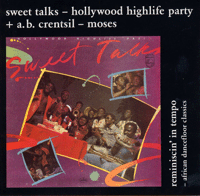
SWEET TALKS
HOLLYWOOD HIGHLIFE PARTY (Popular African Music pam adc 301)
Sweet Talks toured the USA in 1978. They backed the Crusaders, and took time to record their greatest album HOLLYWOOD HIGHLIFE PARTY, but then broke up over financial disputes. Various members, like A. B. Crentsil, Tony Mensah and lead guitarist Eric Agyeman went on to stardom as band leaders. You can see why: this is intricate turn-on-a-dime music, with stop-start rhythms and everyone in the pocket. Sammy Cropper (I think) on bass, is soloing from the start of "Na wa' to be husband." Crentsil formed Super Sweet Talks and recorded the classic "Moses," another biblical rant which got him in trouble with the church at home and banned from the radio airwaves. The sixteen-minute "Moses" is included as a bonus on the "Hollywood Highlife Party" album, reissued by Popular African Music. Some of their most popular songs are here, including "Na wa' to be husband," and "Angelina." (The latter is a wonderful story, in pidgin English, of a flirtatious wife.) The organ bops around like a percussive accent as the guitar goes into a vertiginous spiral. Bound to get your party hopping is the 16-minute "Ye wo adze a oye," which has long percussion breaks, and witty commentary about regional Ghanaian food and the peculiarities of the women who cook it.

LE SUPER CAYOR
SOPENTÉ (Popular African Music pam oa 206)
Among the essential recordings of African music, the series published by Günter Gretz as Popular African Music rank high, and on top of that stack rides SOPENTÉ by Le Super Cayor de Dakar. Basically a Cuban-inspired band singing in Wolof, they take Guillermo Portabales' "El Caballo vamos pa' monte" to new heights on the title cut. The hard swinging salsa-ish cuts from this album have all been anthologized, attesting to their success, but here you get them in the context of some of their Senegalese neighbours. Instead of a rediscovered oldies band, Super Cayor are still keeping the beat alive in Dakar, despite the immense popularity of mbalax and hip-hop there today. They sound like Baobab and Balladins, of course, but have a real groove that is uniquely theirs. In fact theirs is a hybrid of mbalax and salsa, and the restored popularity of the Baobab sound has meant that in the last 7 years more and more bands are reinvigorating the salsa sound that was at the foundation of modern Senegalese pop.
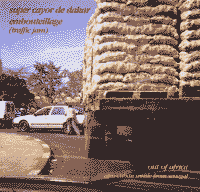
SUPER CAYOR DE DAKAR
EMBOUTEILLAGE (Popular African Music pam oa 210)
In 1997 Steve Fagin made a film about Cuba called TROPICOLA. He couldn't get permission to use Arsenio Rodriguez playing "Somewhere over the Rainbow" as the theme song under the title credits (while a couple drove in a convertible along the malécon in Havana), but the music in his film was choice. He turned me on to a lot of classic Cuban music and in return I cued him in to some great African oldies. I suggested to him we go to West Africa together and make a movie about tracking down Balla et ses Balladins. For a fleeting moment I saw myself as a latter-day Hugh Tracey on an insane quest to reunite a legendary band with Steve getting the whole thing on film in his inimitable way. It was a great fantasy, but melted with the ice cubes in the scotch. Since then some of the old-time West African bands have actually resurfaced are now reaping the benefits of late recognition in the West for their superb canon of works. And leave it to Günter Gretz (who was instrumental in the rediscovery of Baobab), to promote more of the classic Senegalese bands and to record them for his exemplary Popular African Music label from Frankfurt. Gretz, in fact, is the latter-day Hugh Tracey I dreamed of becoming.
While Gretz was pushing his dead van out of the Sahara desert in 1994 he heard SUPER CAYOR DE DAKAR, last examplar of the old-style bands that combined salsa with Senegalese mbalax by switching the timbales for African talking drums. Although Africando was taking the West by storm, the period was not favorable to salsa bands in Senegal. Baobab in fact broke up in the early nineties. But Super Cayor, formed of old band-mates from Star Band, M'bol Cissé and James Gadiaga, scored hits with "Capitale-Region" and "Xamsa Bopp." They toured Europe in 1999 but didn't really catch fire so returned to their weeknight club gigs in Dakar. Gradually their salsa songs became club favorites in the West, cropping up on Candela's SALSA AFRICA compilation and also Earthworks' AFRICAN SALSA (which leaned heavily on the SOPENTÉ album released by Gretz in 1997, including half of it!). Then two years ago Baobab's former leader and saxman supreme, Issa Cissokho, joined Super Cayor.
Gretz points out that the pure mbalax diet wore thin on the local crowd hence the return of salsa, but the salsa you hear in Dakar is truly a local sound, not just rehashed Cuban music. Other influences come to bear on the music of course, as we critics are fond of pointing out when we detect a Jack Bruce bass line or a Hank B. Marvin guitar riff. The latest CD from Super Cayor is titled EMBOUTEILLAGE, which means traffic jam. It does have remakes of several familiar Super Cayor songs but it is still great, and now that Issa Cissokho is on the album it will be required listening for Baobab fans too. The album opens and closes with "Degoo" (heard before on SOPENTÉ), the latter being a faster live version complete with a tres-like trill in the opening guitar part and a touch of feedback (it was recorded by Gretz in a tiny snack bar). It's based on Guillermo Portabales "El caballo vamos pa' monte," but has a unique Senegalese feel to it. The title cut is a remake of "Capitale-Region" with new lyrics and heartfelt sax blowing by Issa. The song now deals in couched terms with the political situation in Senegal, the traffic jam being a metaphor for the deadlock in government, housing crisis, etc. The most Wolof-sounding track was recorded live in Brussels at a festival in 1999 and features Moustique on lead vocals, Sylvain Ndiaye on lead guitar and two other percussionists (Sylvain, the regular guitarist, had broken his arm so was not on the other tracks). Fans of Super Cayor will snap this up. Anyone interested in Baobab, classic Etoile de Dakar, or African music in general will find this a rare treat.
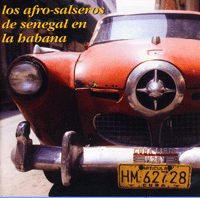
LOS AFRO-SALSEROS DE SENEGAL
EN LA HABANA (Popular African Music pam 407)
Orchestra Baobab added Ibrahim Ferrer to their line-up for one track on their return album SPECIALIST IN ALL STYLES, but Günter Gretz of Popular African Music went one better and accompanied a roster of great Senegalese salseros to Havana to cut an album. Unlike Africando, which was Senegalese singers fronting a band of Nuevo Yorquinos, LOS AFRO-SALSEROS DE SENEGAL EN LA HABANA is not a hybrid, but the best of Dakar's old-time salsa-mbalax musicians working out in the Communist playground. The credit actually goes to the Cuban ambassador to Guinée who invited these artists to come to Havana. Then local politicians stepped in and the list of invitees took on sinister overtones as names appeared and disappeared. Fortunately Günter Gretz was on hand to lobby for a real band rather than a delegation and thus got Issa Cissokho, sax-honking maestro of Baobab and Super Cayor, on the list. In the end however the trip wasn't such a treat for the musicians: In Cuba they had to play in hotel lobbies full of Japanese tourists who weren't listening to the music; not having dollars, the musicians couldn't buy a drink. When they got in the studio and started recording "Esta China," the engineer corrected Pape Fall's Spanish so much he switched to Wolof. There were attempts to sabotage the session, even bribes from a politician because he didn't want a German to have the rights to the recordings, but things worked out in the end and, for the first time, the old rivals from Baobab and Number One de Dakar collaborated beautifully to produce a monumental album. There's a real maturing of the sound here and it is indeed thanks to Gretz that we are now reaping these pleasures. This deserves to be as big as Buena Vista Socialism and if it gets a fair hearing it will be.
Thus members of four top Senegalese bands jammed on 8 classic songs that had all been hits in Senegal (as well as Cuba). First among the vocalists is Labah Sosseh (who sang with Dexter Johnson's bands in the 60s before his solo career). He performs his hit "Aminata." Issa does a great job with the sax lead and then arranger Yahya Fall from Number One de Dakar rips off a confident guitar lead. Next up it's Super Cayor's turn and James Gadiaga sings their hit about breastfeeding with a tune first heard on SOPENTÉ. Then Pape Fall gives us "Teungeuth" (which was heard on the Earthworks AFRICAN SALSA compilation), with the out-of-tune Egrem studios piano adding a really great lopsided momentum, particularly when playing with just the tama. Ousmane Diaw of Super Cayor on bass is incredibly brisk. Issa does a terse sax solo, then Ali Penda comes in on trumpet sounding a bit off-key like the piano. Also known as "Oh Coumba," this song was on Pape Fall and African Salsa's first release KE JARAXAM, released in 1995. After three listenings to the incessantly mad and insistent piano montuno part I can tell this is going to be top ten material for this year.
Mar Seck sings "Borom Gal" in a spirited version with speedy guitar and Ali Penda again soloing on trumpet. A crescendo is reached at the mid-point with Number One's "Diongoma" showing everyone deep in the pocket and a strident lead from Yahya. Another musical convergence occurs with "African Salsa" which has been reprised frequently since Pape Fall first hit with his own band. It was the lead-off track on the Earthworks compilation and is done to a turn here. The set ends with a coasting version of "El Manisero" (as I scream, "Has it finally come to this!??!"). I wish they had done "Diamoule Mawa" instead, but Labah Sosseh has a fine voice and as the senior of these singers probably got to pick the plum for this outing. It's another clean and clear recording, so this is the payoff for all the poorly recorded Senegalese cassettes we've listened to over the years!
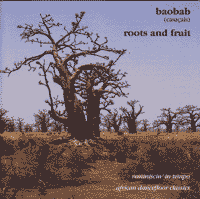
ORCHESTRE BAOBAB
ROOTS AND FRUIT (Popular African Music pam ADC 304)
Truly the greatest band ever to come out of the bustling, sprawling dusty city of Dakar, Senegal, Orchestre Baobab held sway at the nightclub for which they are named throughout the nineteen-seventies. Blending the Cuban influence that was popular in West Africa since the 1940s, with indigenous local forms which gained popularity throughout the sixties as "Authenticité" movements blossomed in the newly-independent countries. The band was formed from the Star band (which eventually gave birth to Youssou Ndour and his Etoile de Dakar) and recorded a dozen popular albums.
Baobab's Roots and Fruits is the fifth CD reissue of Baobab material. It provides a variety of musical styles and some superlative musicianship by Barthelemy Atisso on lead guitar, the smouldering sax stylings of Baro N'Diaye (a student of Dexter Johnson) or Issa Cissokho, and the vocals of Balla Sidibé, Rudy Gomis, and Laye M'boup. The diverse cultural backgrounds of the members brings Mandinka music with traces of Guinean, Malian and even Togolese influences to the sound. In addition to the Cuban tinge on several numbers, and the mbalax style that is endemic to most Senegalese recordings since the seventies, there is a surprising lot of R&B, even echoes of Ethiopian pop in one sax solo (on "Saxaar"), reggae and ska in others. All this demonstrates the incredible range of the assembled members of Baobab. "Cabral" is based on the changes of "Guantanamera," and it's taken at a leisurely gait, characteristic of the Guinean bands of the 1970s who you can picture, leaning back against the wall or their amps, eyes closed behind shades, sweat spreading on their brightly patterned shirts, the cuffs of their frayed bellbottoms sweeping the floor.
Two of the songs on Roots and Fruits, namely "Tante Marie" and "Digone nga ma," were also recorded by the band in their 1978 Paris sessions which are available on Melodie 79559-2. The versions here are fuller, both in sound and in interpretation.
The most uncharacteristic song on this CD is "Toon baaxul" which starts with "one-drop" reggae drumming. It was a 1986 solo recording of Rudy Gomis who quit the band when they changed the line-up to add more percussion and try to lure more female audience members (who in turn would bring males). Atisso contributed the guitar part to this unusual song.
This CD is part of Günter Gretz's superlative series on the Popular African Music label of Frankfurt. Typically it has excellent liner notes, an indispensable discography to help you sort out what has been reissued and what hasn't, and historic photos of the band.
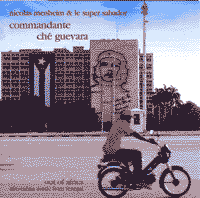
NICOLAS MENHEIM & LE SUPER SABADOR
COMMANDANTE CHE GUEVARA (Popular African Music pam oa 209)
A musical offering that bridges the Atlantic from Senegal to Cuba comes from Nicolas Menheim & Le Super Sabador. Menheim paid his dues in all the right bands: Star Band, Number One and Super Etoile. So he sang alongside Youssou Ndour as well as Pap Seck. In 1991 he was one of the founding trio of Africando, recorded four albums with them and toured the world. He quit to go back to Senegal and formed Le Super Sabador and here we have their first two cassettes united on one album: COMMANDANTE CHE GUEVARA. It's a very Cuban sounding set. The piano is in tune and works out, but the pianist is not credited. There's timbales, maracas and guiro, but no tama. The guiro player, Maguette Dionne, also sings lead on two cuts. She's known as the "Celia Cruz of Senegal," perhaps for being the only female salsero from there. However I also enjoy her solo album which is in my favorites folder. Another vocalist, Camou Yandé, gets to front the band for two songs, one of them by Tabu Ley Rochereau. No other songwriters are credited but there is strong writing on here and really good arrangements, particularly the horn parts (outstanding trombone and two trumpets). The style is montuno with a hint of Senegal and is very smooth.

OUZA & SES OUZETTES
LAT-DIOR (Popular African Music pam oa 208)
LAT-DIOR is a compilation of classic tracks from OUZA & SES OUZETTES from 1976-90. It takes a couple of hearings to get used to the Islamic harmonies, but anyone into the classic Senegalese sound of Baobab and Star Band will gravitate to this. Plus you can trust Günter Gretz to come up with the goods. Here he has combed through Ouza's output (4 LPs, plus two 7" singles from the seventies, and 14 cassettes spanning the eighties and nineties) to deliver another classic. The first few cuts are drawn from a 1990 session with squirty synth but a tasty Wes Montgomery-style lead guitar by Oumar Sow and a quartet of female singers (Les Filles Branchées) that yielded the cassette "Ndar." By the fourth track, the magical ten-minute long "Guajira," we are in the sweet tropical air of the Afro-Cuban night with a brace of saxes and Pape Seck on guitar, among others. The heart of this new PAM release is this session from 1982 with all four tracks of the "Nakhe M'baaye" cassette included where the band covers all styles including speedy mbalax with flanged guitar, tama, and the delightful addition of acoustic piano.
There is a complete discography and liner notes by Gretz who tells us of the controversy of Ouza's politics in his many songs, and various bands formed by Ouza including one with Baaba Maal in the early eighties. He also notes that there is an exceptional album called "Ouza et Les 4 Femmes dans le Vent" featuring four women singers who went on to solo prominence in Senegal. "Wherever you find it buy it. The sound is poor. I have tried in vain to find the master," Gretz adds parenthetically, indicating the kind of effort he puts into his productions.
Two of the LPs in the discography were the source for ten tracks on the Senegal Flash series that Syllart put out around 1993, so have not been included here. But one track from WETHE has been included, the slow rocker "Senegal 80" with its familiar "Hang on Sloopy" 12-bar stroll. Another of the tracks, "Thiaroye," is an important song because it discusses the French massacre of Senegalese troops after World War II. Despite its sympathetic message, it led to censure by President Senghor. (You can find it on SENEGAL FLASH-BANJUL).

VARIOUS ARTISTS
MUSIC FROM SAO NICOLAU (Popular African Music pamap603)
The latest Cabo Verdean sound is a twenty-year-old recording, MUSIC FROM SAO NICOLAU put out by Popular African Music in conjunction with the University of Mainz Institute for African Studies. São Nicolau is one of the minor islands in the Cabo Verdean archipelago and remains relatively isolated from the rest of Africa. The music there thrives in its own world without too much outside influence but still, in the two decades since this album was recorded, zouk, rock and reggae have overtaken the youth and many of the older forms documented here are no longer being played. The cavaquinho player of the Da Cruz ensemble is already working some reggae chops behind the gypsy-like violin on track 16, "Regui." The music is very lyrical with mellow acoustic guitar duos and trios. The songs are mostly slow and tend to be mournful. There is a version of "Sodade (Nostalgia)" that will be familiar to fans of Cesaria Evora that combines samba and coladeira. Larger ensembles add violin and cavaquinho. One carnaval march, "Estrela Azul" ([wherever you go you're sure to find a] Blue Star) could be right out of the streets of Rio. There are two poignant songs of a young laundress, accompanied by her washboard; a nightwatchman who improvises verses with his strangely tuned 10-string guitar that put me in mind of Barbecue Bob for a moment. The CD ends with three short yells to scare away birds from the grain fields.

NEMA MINT CHOUEIKH
MAURETANIAN MUSIC FROM THE TRARZA REGION (Popular African Music pam oa 211)
Günter Gretz is a determined individual. Most of us, on hearing a great piece of music in a film, might wait till the end and read the credits to see who the artist was and, if we remembered later, try to find their music on-line or at a record store. Gretz however is out-of-the-ordinary, not least in the movies he goes to. The movie he was watching was En Attendant le Bonheur (Waiting for Happiness) by Malian director A. Sissako & the moment that made his hair and ears stand up was when Nema Mint Choueikh was teaching a young girl a traditional song. It just so happened that in 2003 Gretz was driving through the town of Noaudhibou, in the Trarza region of Mauretania, where the film was shot, on his way to Senegal. He inquired and was told the singer lived further along in another town but when he got there he found he had passed her house on the road long before and, as he had an appointment in Senegal, he couldn't turn back. A year later he was back in Noaudhibou and learned there was to be a music festival with Nema performing one week later, so he returned to catch her act and hopefully hook up with her. Again her voice sent shivers down his spine, but as soon as she left the stage she got into a limo for the airport and a flight to Paris! He left a message with the concert promoter and 14 months later was back to finally meet Nema and record her. But at this point a sandstorm was brewing and the tin rooves of the houses were beginning to rattle ominously but, undaunted, Gretz set up his recording equipment and went for it, working for 3 hours to capture Nema and her ensemble performing for this CD release. It is traditional Moorish music. Nema sings and is accompanied by hand-claps and a couple of thwocking string instruments, the tidinit a small hour-glass shaped lute with five strings, and a kora-like instrument, the ardin, which is played by women. Sometimes an acoustic guitar can be heard, but the bending notes of the ardin are most unusual like it's constantly being tuned, while the tidinit embroiders the melody like the Manding ngoni. There is also a deep drum called the tbal. Between the songs the musicians do indeed tune-up so the music doesn't stop, it just goes into a lull of very out-sounding noodling for a few seconds between tracks. While the concert is acoustic there is one interesting note. A bullhorn is used (it can be seen on the cover), not for singing but to pick-up and amplify the guitar and tidinit. It sits on the ground next to the pick-up of the instrument and can often produce wild Hendrix-esque distortions. This is a wonderful recording and a window into a traditional world that is of course rapidly shrinking. Gretz promises if people buy this album and support his label, instead of copying it and ripping him off, he will release an album of electric guitar & tidinit music from Mauretania next.
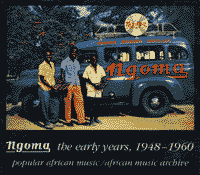
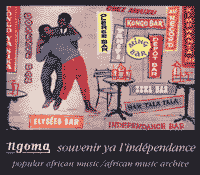
NGOMA, THE EARLY YEARS (Popular African Music pamap101)
NGOMA, SOUVENIR YA L'INDEPENDANCE (Popular African Music pamap102)
Ngoma was the first important label to record native musicians in Congo, starting in 1948. The Early Years covers their development with one or two familiar names, Wendo, Camille Feruzi, and some more obscure but brilliant artists like Adou Elenga, Leon Bukasa and Trio Bow. The history of Congolese music is told here, from "Marie-Louise" to "Maria Tchebo", in twenty-five 3-minute songs -- the cream of the label -- thoroughly annotated (by Dr Wolfgang Bender) with photos too. It's a dream of a package.
The Ngoma label was formed by an Egyptian trader of Greek descent, Nico Jéronomidis in 1948 simply because he enjoyed the local music he heard in Léopoldville and recorded some of it for himself. His friends heard it and urged him to start a record label. Tragically Nico died young in 1951 and his brother Alexandros carried on the label.
Word came down that during the Civil War in Congo the archives of Ngoma had been trashed. In fact Jéronimidis' heirs had offered the archives to the State in 1973 and then to Mobutu personally in 1975 and had been ignored, so they were left as prey for the looting mobs. To compound the tragedy, the master tapes had been lost at a fire in the French pressing plant in 1963 so now nothing remained of Ngoma, except whatever records were out in the world. Gretz was able to find 51 singles, that had been preserved at the University of Mainz Institute of Ethnology and African Studies, in good shape and issued them in two volumes as a history of this key label in the development of Congolese music. Souvenir ya l'Independance focusses on the music released around Congolese Independence in 1965. Sax players Isaac Musekiwa and Manu Dibango are the best-known names on here but Paul Mwanga and Leon Bukasa are outstanding and have to be heard. The Isaac Musekiwa tracks are by Vedette Jazz (one is a twist in mock-english) and have a wild jagged guitar solo by Misia Albert. Musekiwa is best-known as a long-time member of OK Jazz, he joined Vedette Jazz in 1959 when Franco was temporarily locked up. The Beguen Band featuring Tchadé are outstanding; in the tango recorded in 1961, you can hear their influence on later bands.

SEKOUBA "BAMBINO" DIABATE
LE DESTIN (Popular African Music pam oa 202)
Bembeya Jazz's virtuoso lead singer is presented here in a lively set. The daddy of all Guinean-Malian blues singers, Sékouba was born in Siguiri (Upper Guinea) in 1963. His talents were evident from an early age, and soon he was fronting the great Bembeya Jazz alongside his near-namesake Sekou "Bembeya" Diabaté aka "Diamond-Fingers," the legendary guitarist. Sékouba does play acoustic guitar (on his recent release from Sterns), but he mainly plays ngoni & percussion on this outing. Traditional instruments, kora, balafon and djembé are featured. This album was released on cassette in Abidjan in 1992 and sold 160,000 copies in three months, making it the most popular album throughout West Africa. Like the Mory Kante & Salif Keita albums that were tearing up the clubs in Paris at the time, this has Linn drums (programmation) on it. But to some extent this is mitigated by the wild balafon that counters the mechanical qualities of the rhythm. There is also blistering lead guitar from Lanciné Diabaté. For this reissue Gretz added the two best cuts from the previous solo cassette release.
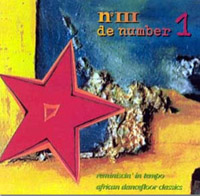
NUMBER ONE DE DAKAR
No III DE NUMBER ONE (Popular African Music pam adc 307)
Since Ted Jaspers at Dakar Sound was also documenting the early music of Senegal in his superlative series of CD issues, Gretz decided not to crowd him but to augment that series with another of his "african dancefloor classics" series (also known as "reminiscin' in tempo"), in 1994. Again tracks were culled from obscure originals -- LPs and cassettes -- but avoiding duplication with the Dakar Sound brace of issues of Star Band Number One. There's plenty of gold still in the hills! "Liti-Liti" went into heavy rotation on my radio program, and there are 11 tracks of stellar quality on this disc. Because the album is drawn from different periods in the band's evolution, 23 musicians are listed, Falls, Diops and N'diayes among them. The industrious Yahya Fall plays guitar on all tracks, Thierno Kouyaté is the main saxophonist, Pape Seck and Mar Seck are the featured vocalists but several others, including Nicolas Menheim, Mbaye Diop and Pape Djiby Ba get a shot on the mic. They kick off with a unique version of Arsenio Rodriguez' "Bruca Manigua," and follow up with more of their special blend of ragged vocals and clashing horns trading off on mostly slower Cuban rhythms. At first the tracks seem extremely laid back (until the guitar fires up). "Takoussane" explodes in all directions.
The percussion instruments include conga, timbales, guiro and tama, so you can guess that rhythmically it's a wild mix of mbalax and salsa. The bonus is Yahya Fall (since there's no guitar like this in Cuban music), especially when he turns on the tube screamer. The liner notes list nine albums and cassettes that the tracks were drawn from. I searched for years to find two of their LPs, so we must be grateful to Gretz for getting it together so efficiently for us. Like the two Dakar Sound CDs that preceded it, there are memorable tracks on here that will stick in your brain and you will want to hear them over and over till they are engrained in your soul.